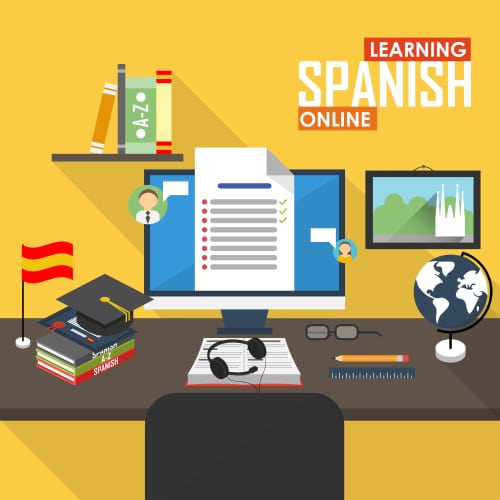What is the best way to learn Spanish? To be honest with you, I don’t know. And I promise you, no one else knows either.
Many “experts” will tell you to register for a Spanish course. Some will tell you to get a Spanish-speaking buddy. Still others will say the best way is via immersion in a Spanish-speaking country.
All these methods are effective. However, there is no proof any one method is the best. It is my opinion that each person learns differently, and so at the end of the day what works for me might not necessarily work for you.
The four foundational skills of learning a language (speaking, writing, reading, and listening) can only be achieved when you listen a lot, speak a lot, write a lot, and read a lot. That’s a given. The question, therefore, has to be what do you do to incorporate all four foundational skills to learn a language like Spanish.
Notwithstanding my opening remarks, I do believe that of all the methods that exist, immersion is quite effective in helping non-Spanish speaking persons to learn the language – whether at home or abroad.
Of course, simply being immersed in the culture, while it will definitely force you to speak the language and understand the culture better, may not help you to master the grammatical component of the language. Therefore, I am going to give you a combination of methods in answer to the question, “What is the best way to learn Spanish,” with the caveat of what I said earlier.
Here then are suggestions (which you could call the Best Way to Learn Spanish) that hopefully, will assist you, regardless of your learning style.
Listening to Spanish
In order to actively listen in Spanish on a regular basis, you will need to be immersed. Immersion comes either through visiting a Spanish-speaking country, or listening at home to Spanish-speakers whether via the radio, television, friend/tutor, or a podcast.
Podcasts have become quite popular because they give you access to real conversations while you are driving, walking, etc. All you need is a headset and you’re ready for the immersive experience.
The key is to choose podcast sites with topics that interest you.
So for example, if you’re into news, you could subscribe to News in Slow Spanish, which is a weekly podcast of news reports read in Spanish. The free introduction to each episode is a good place to start.
You can also visit YouTube where you will find numerous Spanish-speakers on almost any activity that interests you.
Watching movies in Spanish is also quite effective, especially watching movies you are familiar with, i.e. you have already watched in English and are aware of the plot and the outcome. This allows you to focus more on the language, which you can do while engaging in other tasks.
I’ve put on a movie and then go into the kitchen to prepare dinner. I can hear the movie being played, but I cannot see it. However, I know the movie, so all I’m doing is developing my listening skills.
You can also turn the television on and leave it, just to get the Spanish immersive experience. You may not immediately understand what is being said, but your ears are becoming acclimated to hearing the language, and being familiar with the sound of the language. Univision, TNT Latin America, are just a few of the places to start.
Reading in Spanish
In addition to listening to Spanish, you must read in Spanish. The idea is to get as much of the language into your memory, your cognition, and your knowledge base. Reading in Spanish will also help you to improve your use of the grammatical component of the language.
The Oxford Spanish Dictionary is a good place to start. Not only are you learning the meaning of words, but you are also building your vocabulary. Barron’s Foreign Language Guide is also another great resource. Their 501 Spanish Verbs with CD-ROM and Audio CD (501 Verb Series) 7th Edition alphabetize each verb in “easy-to-follow” chart form – listing one verb per page along with its English translation.
In order to speak fluently, you will need to improve your vocabulary. So reading newspapers, magazines, books, and any other literature in Spanish will definitely help to increase your vocabulary.
Writing in Spanish
Having received the information through reading and listening, you must also assess your abilities, and you do this through writing and speaking. One of the best ways to practice writing Spanish is by keeping a journal.
As a writer, I love to keep journals.
Many people, however, say they do not like to keep journals because of the potential lack of privacy if it falls in the wrong hands. Imagine writing in Spanish among your English-speaking friends and family. That thought alone should prompt you to start writing in Spanish.
Speaking in Spanish
In addition to writing Spanish, you do need to develop the skill of speaking in Spanish.
In order to speak any language, you will need to have a vocabulary. You can speak with a small vocabulary, but it will not make you fluent or be able to speak with certain demography among Spanish-speakers.
As such, to speak Spanish fluently with your coworkers or business associates, for example, require you to learn all the idioms and phrases related to business. Having a medium to large vocabulary is also necessary to speak fluently. FluencyCorp offers on-site workplace language training to help professionals improve their Spanish.
Other methods of learning Spanish
Mnemonics
When I was learning Spanish in high school, my teacher taught us rhymes and songs to help us remember idioms and phrases in Spanish. We call this mnemonics.
Mnemonics help us with vocabulary, grammar, and other language devices. By relating words or phrases with a picture in your mind or a familiar story or song, you have a better chance of memorizing irregular conjugations, for example.
The wonderful machinery that is our brain has the ability to associate old information with new information.
So for example, you can remember the days of the week by using sentence mnemonics. A popular one is Lucy Makes My Journeys Very Special where each initial letter corresponds with the Spanish equivalent: Lunes, Martes, Miercoles, etc.
As an adult, this one has actually helped me to remember the days of the week as I sometimes mix up Thursdays with Fridays.
You can also use acronyms, stories, rhymes, words and sound associations, and stressed syllables to remember words and phrases in Spanish.
Being Consistent
I’ve come to the conclusion that had I been consistent, I would have been speaking fluent Spanish much quicker.
If you want to improve your Spanish, develop the habit of practicing Spanish every day. They say a habit takes seven times to form. That means if you start practicing Spanish today, in a week, you should develop the habit.
The trouble is, we start today and maybe tomorrow, then something “comes up” and we stop for a few days then resume. I know, that’s my story. Not yours.
However, try to work on a simple routine. Start with a regular habit of listening to a Spanish podcast for 10 – 15 minutes a day, and continue doing it for a month even if you are listening to it while walking, driving, etc.
In conclusion, the best way to learn Spanish may be different for each person, but the key to learning Spanish is exposing yourself to the language as much as possible using multi-sensory activities. Do what works for you, but do it consistently. Whatever keeps you motivated to continue learning, is what will keep you consistent.
What is the best way to learn Spanish?
It depends on the person. What do you think is the best way to learn Spanish is for you?
Are you ready to improve your Spanish and become fluent? Let our TruFluency language coaches help you with tips like the ones above and more. Choose a Spanish tutor today and save 20% off your first month of lessons with code TF20!





